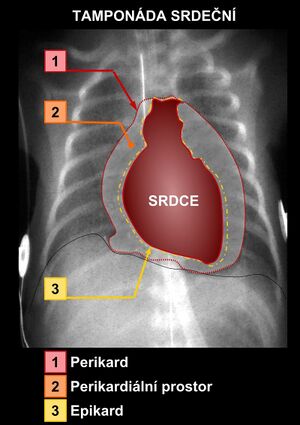Cardiac tamponade
Cardiac tamponade is an acute, life-threatening condition that without urgent treatment leads to failure of the heart as a pump and thus to patients death.
The Heart is stored in the chest cavity in the so-called pericardial' (cardiac) sac. Between the epicardium (the outer layer of the heart wall) and the pericardium is only a small space filled with about 20−50 ml of serous fluid. This serous fluid is an ultrafiltrate of the bloodplasma and allows the epicardium and pericardium to slide smoothly against each other.[1]. The pericardium is expandable, together with the heart wall it dilates during diastolic filling, which does not restrict the heart functionally.
During some pathological conditions, however, there can be accumulation of a larger amount of fluid in the pericardial sac (in the space between the epicardium and the pericardium), intrapericardial pressure increases (the fluid exerts pressure on the heart - the heart is oppressed) and the heart becomes as if it was into a corset' - it is no longer able to dilate properly during diastole. There is a disturbance in the diastolic filling of the heart, hypotension and a decrease in cardiac output (low output syndrome). The function of the heart as a pump fails, hypotension leads to tissue hypoperfusion and the development of a shock state.
Hemodynamic significance of cardiac tamponade depends on the speed of fluid increase' in the pericardial space. A relatively small effusion (200–300 mL) accumulated over a short period of time may manifest as cardiac tamponade, while a relatively large increase (1000 mL) occurring slowly over a long time horizon may not manifest clinically[2].
Causes[edit | edit source]
In cardiac tamponade, the heart may be oppressed by:
- effusion (pericarditis – infection, cancer, autoimmune disease including post-pericardiotomy syndrome, ...);
- by blood or blood clot (MI associated with a rupture of the left ventricular wall, rupture of the ascending aorta, complications of cardiac surgery, heart trauma).
Clinical manifestation[1][edit | edit source]
In 1935, Beck established a clinical trias characteristic of rapidly developing tamponade (e.g. rupture of the LV wall during MI):
- hypotension (decrease in systemic arterial pressure);
- dilation of jugular veins (increase in central venous pressure);
- weakening of heart sounds.
→ Hypotension and tachycardia are clearly dependent on the breathing phase. During inspiration, the pressure drops a lot and the pulse is hard to feel, while exhaling blood pressure increases and the pulse is better felt. This is due to the fact that, when breathing in, the enlarged lungs compress the already oppressed heart even more. We also find:
- tachycardia';
- pulsus paradoxus';
- signs of tissue hypoperfusion (moist, cool skin; peripheral cyanosis; dyspnea);
- restlessness, anxiety;
- vertigo, disorder of consciousness;
- shock state.
Diagnostics[edit | edit source]
The diagnosis of cardiac tamponade relies on:
- anamnesis';
- clinical symptoms' (see above);
- X-ray;
- echocardiographic examination (gold standard, but often cannot be performed due to the peracute course or the absence of an echocardiograph).
In diagnostically unclear situations with good availability, CT' and/or MRI can be used.
As a differential diagnosis, it is necessary to exclude other causes of obstructive cardiogenic shock (e.g. pulmonary embolism, myocardial infarction, aortic dissection extending into the pericardium) and tension pneumothorax. [3]
Treatment[1][edit | edit source]
- Pericardiocentesis. This is a puncture of the pericardium to evacuate the pericardial fluid.
- In hospital conditions, it is performed under echocardiographic control or can be intervened by cardiosurgery (thoracotomy and pericardiotomy).
- In the field, the pericardium is scored blindly. The patient assumes a semi-sitting position. I insert the epidural needle to the left of the xiphoid process at an angle of about 35° under the ribs towards the left nipple. For constant aspiration we approach the heart. We are waiting for a faint popping sound signaling penetration of the pericardium and subsequent aspiration of blood.
The performance carries a 'risk of laceration of the pericardium and heart, injury to the coronary artery or lung. The mortality rate of blind pericardiocentesis is around 20%.
- Followed by 'treatment of the primary cause of cardiac tamponade.
Interesting[edit | edit source]
Rupture of the heart wall can also be caused by a stab wound. This mechanism caused the death of Empress Sissi, whose heart was pierced by an assassin with a sharpened file. The hole in the pericardium closed after the murder weapon was pulled out, but blood began to flow through the small hole in the heart wall into the cavity of the pericardium. Paradoxically, the empress did not feel the sting at all, she had the impression that a passer-by had just pushed her, and she continued walking after the assassination. She collapsed only after walking several tens of meters, when cardiac tamponade developed.
Links[edit | edit source]
Related articles[edit | edit source]
Video[edit | edit source]
Reference[edit | edit source]
- ↑ a b c VAVRUŠOVÁ, B, P DOČKALOVÁ a J PUDIL. Tupá poranění srdce [online]. ©2006. [cit. 2010-09-20]. <http://www.zachranarivlockari.wz.cz/download/tupe_srdce.pdf>
Cite error: Invalid
<ref>tag; name "Vavruš" defined multiple times with different content Cite error: Invalid<ref>tag; name "Vavruš" defined multiple times with different content - ↑ VANĚK, Ivan, et al. Kardiovaskulární chirurgie. 1. vydání. Praha : Karolinum, 2003. 236 s. ISBN 8024605236
- ↑ SHARMA, Nitish K a James R WAYMACK. Acute Cardiac Tamponade [online]. ©StatPearls Publishing. Poslední revize 2018-12-24, [cit. 2019-10-28]. <https://www.ncbi.nlm.nih.gov/pubmed/30521227>
Source[edit | edit source]
- ŠTEFÁNEK, Jiří. Medicína, nemoci, studium na 1. LF UK [online]. [cit. 2010-09-20]. <http://www.stefajir.cz/index.php?q=tamponada-srdce>
Used literatury[edit | edit source]
- VANĚK, Ivan, et al. Kardiovaskulární chirurgie. 1. vydání. Praha : Karolinum, 2003. 236 s. ISBN 8024605236.
- VAVRUŠOVÁ, B, P DOČKALOVÁ a J PUDIL. Tupá poranění srdce [online]. ©2006. [cit. 2010-09-20]. <http://www.zachranarivlockari.wz.cz/download/tupe_srdce.pdf>.
- KACHLÍK, David a Štěpán JELÍNEK. Srdce : Morfologický seminář [online]. ©2004. [cit. 2010-09-20]. <https://www.lf3.cuni.cz/histologie/materialy/ppt/srdce.ppt>



